
Journal of Optics-India
Scope & Guideline
Exploring the Depths of Optical Knowledge
Introduction
Aims and Scopes
- Optical Materials and Structures:
Research on the synthesis, characterization, and applications of various optical materials, including semiconductor nanocrystals, thin films, and photonic crystals. - Laser Technology and Applications:
Exploration of laser-based technologies, including laser-induced breakdown spectroscopy, laser ablation, and laser design for various applications in sensing and communication. - Nonlinear Optics and Solitons:
Study of nonlinear optical phenomena, including soliton dynamics, self-focusing effects, and the mathematical modeling of nonlinear Schrödinger equations. - Biosensing and Biomedical Applications:
Development of optical sensors and devices for biomedical applications, including cancer detection, glucose monitoring, and other health-related diagnostics. - Optical Communication Systems:
Investigations into optical communication techniques, including free-space optics, wavelength division multiplexing, and radio-over-fiber systems. - Photovoltaics and Energy Harvesting:
Research on solar cell technologies, including perovskite and thin-film solar cells, focusing on efficiency improvements and material innovations. - Quantum Optics and Photonic Devices:
Studies related to quantum optics, including entangled states, quantum dot lasers, and applications in quantum computing and communication.
Trending and Emerging
- Nanophotonics and Plasmonics:
Research in nanophotonics, particularly involving plasmonic materials and structures, is rapidly increasing as they enable new functionalities for sensors, imaging, and energy harvesting. - Integration of Machine Learning with Optical Systems:
There is a growing trend in applying machine learning algorithms to enhance optical systems, including image processing, defect detection, and predictive modeling in optical networks. - Advanced Photonic Devices for Communication:
Increasing focus on the development of advanced photonic devices such as optical modulators, switches, and sensors that support high-speed data transmission and communication applications. - Sustainable and Green Photonics:
Research aimed at developing environmentally friendly materials and processes for optical applications, particularly in solar energy harvesting and energy-efficient devices, is gaining traction. - Quantum Technologies and Photonics:
There is a burgeoning interest in quantum optics, particularly in developing quantum dots and other quantum materials for applications in quantum communication and information processing.
Declining or Waning
- Classical Optical Techniques:
There has been a notable decline in research focused on classical optical techniques, such as basic lens design and traditional optical imaging methods, as more innovative and advanced methods gain attention. - Theoretical Studies without Experimental Validation:
Papers that propose purely theoretical models without accompanying experimental validation are becoming less frequent, as the emphasis shifts towards studies that combine theory with practical applications. - Simple Optical Sensors:
Research on basic optical sensors with limited functionality is waning in favor of more complex and multifunctional biosensors that offer higher sensitivity and specificity. - Conventional Materials for Optical Devices:
There is a decreasing trend in research focused on conventional materials like simple glass and standard optical coatings, as new materials and nanostructured composites become more prevalent in optical device research.
Similar Journals
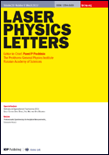
LASER PHYSICS LETTERS
Advancing Knowledge in Laser PhysicsLASER PHYSICS LETTERS is a prestigious peer-reviewed journal published by IOP Publishing Ltd in the United Kingdom, focusing on the burgeoning field of laser physics and its applications. With an ISSN of 1612-2011 and an E-ISSN of 1612-202X, this journal stands at the intersection of innovative research and practical applications, addressing diverse topics within the realms of Instrumentation and Physics and Astronomy. Recognized for its impactful contributions, it boasts a ranking within the Q3 quartile for both relevant categories as of 2023, reflecting its steady rise and commitment to advancing knowledge in the area. Researchers and practitioners are encouraged to explore its content and contribute to the ongoing discourse that shapes the future of laser technologies. While LASER PHYSICS LETTERS does not currently offer open access options, its rigorous selection criteria ensure that published work is of the highest quality, positioning it as a vital resource for anyone engaged in laser science and engineering.

JOURNAL OF RUSSIAN LASER RESEARCH
Exploring Innovations in Laser TechnologiesThe Journal of Russian Laser Research, published by Springer, stands as a vital resource for researchers and professionals in the fields of atomic and molecular physics, as well as optics and engineering. With its ISSN 1071-2836 and E-ISSN 1573-8760, this journal has been disseminating groundbreaking research since its inception in 1994, with a dedicated focus on the advancement of laser technologies and their applications. While it currently holds a Q4 classification in both Atomic and Molecular Physics and Engineering categories, its commitment to fostering novel insights and innovative methodologies positions it as a promising platform for emerging studies within these disciplines. Although the journal does not offer open access options, it continues to draw attention with a growing citation index. By publishing diverse research articles, reviews, and critical discussions, the Journal of Russian Laser Research not only enriches academic literature but also serves as a stepping stone for students and professionals seeking to deepen their understanding of laser science and its myriad applications.
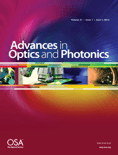
Advances in Optics and Photonics
Connecting Researchers in the Realm of LightAdvances in Optics and Photonics, published by the Optica Publishing Group, stands at the forefront of research dissemination in the fields of Atomic and Molecular Physics and Optics, alongside its prominence in Water Science and Technology. With an impressive Q1 ranking in both categories and a Scopus rank of #2/224, this journal boasts a 99th percentile status, underscoring its significance in the academic community. As a beacon of knowledge since its inception in 2009, the journal is dedicated to featuring cutting-edge research, innovative methodologies, and transformative applications in optics and photonics that can drive advancements across diverse scientific domains. While not an open-access journal, it provides vital insights for researchers, professionals, and students eager to stay updated on emerging trends and breakthroughs. With a convergence period extending to 2024, Advances in Optics and Photonics is positioned as an essential resource for anyone looking to explore the evolving landscape of light-based technologies.
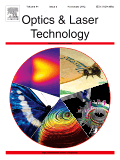
OPTICS AND LASER TECHNOLOGY
Cutting-edge Research for a Brighter TomorrowOPTICS AND LASER TECHNOLOGY, published by Elsevier Science Ltd, is a premier journal dedicated to advancing knowledge in the fields of optics and laser applications. With its impressive Q1 rankings across three critical categories—Atomic and Molecular Physics, and Optics; Electrical and Electronic Engineering; and Electronic, Optical and Magnetic Materials—the journal stands at the forefront of scientific discourse, boasting a significant impact factor that underscores its relevance. Since its inception in 1970, the journal has consistently provided a platform for the dissemination of cutting-edge research, key innovations, and reviews that influence both academic study and practical applications. Although it currently does not have open access options, its rigorous peer-review process and inclusion in esteemed indexing services make it a valuable resource for researchers, professionals, and students seeking to stay informed about the latest developments in optics and laser technology. The journal’s ongoing commitment to quality research ensures it remains a vital publication for those engaged in this dynamic field, with a converged projection extending through 2025.
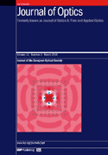
Journal of Optics
Advancing Knowledge in Light and MatterThe Journal of Optics, published by IOP Publishing Ltd, stands as a pivotal platform for disseminating cutting-edge research in the fields of atomic, molecular physics, and optics as well as electronic, optical, and magnetic materials. With an impact factor reflective of its esteemed position—ranking in the 60th percentile in both relevant Scopus categories—this journal, boasting an ISSN of 2040-8978 and an E-ISSN of 2040-8986, is uniquely positioned to foster innovation and collaboration among researchers, professionals, and students worldwide. Located in the United Kingdom and operational since 2010, the journal embraces an open access model, promoting maximal reach and engagement with the latest discoveries that shape the future of optics. As it continues to evolve through its converged years up to 2024, the Journal of Optics remains a critical resource for those seeking to advance their knowledge and influence in this dynamic field.
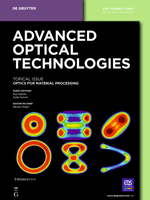
Advanced Optical Technologies
Illuminating the Future of Optical ResearchAdvanced Optical Technologies is a reputable journal dedicated to advancing the field of optics and photonics, published by FRONTIERS MEDIA SA in Switzerland. Since its inception in 2012, the journal has made significant contributions to the domains of Atomic and Molecular Physics, Electronic, Optical and Magnetic Materials, and Instrumentation, achieving commendable rankings within these categories, including a Q2 quartile classification in 2023. With an emphasis on open access, Advanced Optical Technologies aims to facilitate the rapid dissemination of research findings, thereby fostering collaboration and innovation among researchers, professionals, and students alike. The journal serves as an essential platform for cutting-edge research articles, reviews, and technical notes, and its commitment to quality is reflected in its robust Scopus rankings. As the field of optical technologies continues to expand, this journal plays a crucial role in highlighting pivotal advancements and promoting interdisciplinary dialogue among scholars in the scientific community.
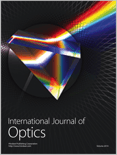
International Journal of Optics
Exploring the Frontiers of Optical ScienceWelcome to the International Journal of Optics, a distinguished publication dedicated to advancing the field of optics and its interdisciplinary applications. Published by HINDAWI LTD, this open-access journal has been pivotal in fostering knowledge since its inception in 2009. With a robust focus on atomic and molecular physics as well as electronic, optical, and magnetic materials, the journal has carved its niche within Q3 quartile rankings in these categories for 2023, signifying its growing impact and relevance in the scientific community. Researchers and professionals will find a rich repository of innovative and cutting-edge research articles that not only address fundamental aspects of optics but also explore practical applications across various domains. The journal's aim is to promote high-quality research dissemination, enhancing collaboration among scientists and ensuring that pivotal findings reach a global audience. Join us in exploring the dynamic world of optics—where your contributions help shape the future of science.

Chinese Optics Letters
Pioneering insights in the realm of optics.Chinese Optics Letters is a prestigious academic journal published by Chinese Laser Press, dedicated to advancing the fields of atomic and molecular physics, optics, as well as electrical and electronic engineering. Since its inception in 2003, this journal has become a significant platform for researchers and professionals to disseminate innovative findings and foster collaboration within these rapidly evolving disciplines. With a commendable Q2 ranking in leading categories including Atomic and Molecular Physics and Electronic, Optical and Magnetic Materials, it ranks favorably within the Scopus database, with notable positions in both engineering and materials science sectors. The journal is headquartered in Shanghai, China, and while additional open access options are not specified, it remains a vital resource for those committed to pushing the frontiers of optical research and applications. As we approach 2024, Chinese Optics Letters continues to play an essential role in shaping scholarly discourse and technological advancement in optics.
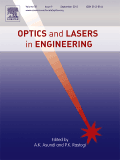
OPTICS AND LASERS IN ENGINEERING
Connecting Ideas in Optics and Laser EngineeringOPTICS AND LASERS IN ENGINEERING, published by Elsevier Science Ltd, is a premier journal dedicated to advancing the field of optics and laser technology in engineering applications. With a robust ISSN of 0143-8166 and E-ISSN 1873-0302, this journal is positioned within the top quartile (Q1) across several categories, including Atomic and Molecular Physics, Electrical Engineering, and Mechanical Engineering as of 2023, showcasing its prestige and impact in the scientific community. The journal has consistently ranked high in Scopus, notably within the top 10% for Mechanical Engineering and Electronic, Optical, and Magnetic Materials research. Since its inception in 1980, OPTICS AND LASERS IN ENGINEERING has served as a vital platform for disseminating cutting-edge research, fostering innovation and collaboration among researchers, professionals, and academia. Though it does not currently offer Open Access options, its high impact factor and selective publication process ensure that articles reach a wide audience while maintaining rigorous academic standards. Researchers and students alike are encouraged to engage with this influential journal to contribute to and stay abreast of advancements in optical technologies and their engineering applications.

Nonlinear Optics Quantum Optics-Concepts in Modern Optics
Illuminating the Future of Optical ScienceNonlinear Optics Quantum Optics-Concepts in Modern Optics is a specialized journal published by OLD CITY PUBLISHING INC, focusing on the forefront of research in nonlinear optics and quantum optics. With an ISSN of 1543-0537 and an E-ISSN of 1944-8325, this journal serves as a pivotal platform for the dissemination of innovative concepts and findings in modern optics, significant for both theoretical exploration and practical applications. Established in 2003, the journal's scope encompasses critical areas such as atomic and molecular physics, optical materials, and instrumentation, attracting submissions from a diverse range of interdisciplinary fields. While the journal currently maintains a Q4 ranking in several categories, it continues to strive for higher visibility and impact in the academic community. Researchers and students alike will find valuable insights and contributions that foster advancements in optical science and engineering. With an emphasis on rigorous peer-review, Nonlinear Optics Quantum Optics-Concepts in Modern Optics is committed to enhancing the understanding and application of nonlinear optical phenomena in various technological domains.